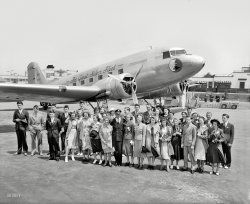
MAY CONTAIN NUTS

Search Shorpy
SHORPY ART

Framed or unframed, desk size to sofa size, printed by us in Arizona and Alabama since 2007. Explore now.
Join and Share
Ad-Free Shorpy
Shorpy is funded by you. Patreon contributors get an ad-free experience.
Learn more.

Recent comments
- Treescaping
- +112
- Rear View
- Way in the back --
- Button It Up
- And with an eye on the time ...
- Working in an enclosed ashtray
- Rear View Mirror?
- Tobacco cam
- Basic fact I learned only later in life
- Put a Lid on it!
- Pinstripes in the Tower
- Sound enhancement
- 3438 in '38
- Second Career
- Their days are numbered
- Only the Sensor
- Train control mechanism
- Rarest of the Rare?? & Classy 3400 Class
- Control Mechanism
- Those standpipes
- Wrenches
- International D-40 I believe
- Job prospects
- You had me at Train
- Land of the free
- Broad-Exchange Bldg
- Parking innovation
- The old block
- "Peck turned a sweet propeller"
Member Photos
The Shorpy
Printporium
Printporium
Search Shorpy
Search results -- 30 results per page
- Daddy's Boy: 1942
- ... the laundry, the boys making a model plane and sleeping at night) and still manage to elicit such genuine emotion as with the dad hoisting ... Posted by Dave - 01/28/2017 - 11:54pm -
![Daddy's Boy: 1942 September 1942. "Rochester, New York. Mrs. Babcock, Shirley and Earl greeting Mr. Babcock in front of the house." The nucleus of this nuclear family, orbited by his little electron. Large format negative by Ralph Amdursky. View full size.
A Little Known ModelWhat a strange car in the Babcock's driveway. Look at the Shorpy logo on its right front fender.
[The poor abused apostrophe. Which of these nice people would be "the Babcock"? - Dave]
I think that the word "the" preceding the family's name makes it the collective Babcock family and that that renders my apostrophe unharmed. Not too sure though.
[These people are the Babcocks, and this is the Babcocks' driveway. - Dave]
Too Young & Too OldMr. Babcock falls into that odd category my paternal grandfather also shared. Too young for WWI, yet too old (and supporting a family) for WWII.
Great jobIt really makes you wonder how the photographer was able to shoot the Babcock family in so many situations (listening to the radio, Mom doing the laundry, the boys making a model plane and sleeping at night) and still manage to elicit such genuine emotion as with the dad hoisting Earl in the air upon his return home. It's a credit to his skill at what he does. As for the look on the mom's face, she's obviously a bit more reserved than the others, and it may very well be that she's bursting with pride and happiness at her husband and little boy.
RationingThe "A" sticker entitles him to 3 gallons of gas a week, the lowest civilian grade. You get that if you certify that you own five tires or fewer. The rest had to be turned in.
Daddy's carA 1939 Plymouth.
Defroster/Air ConditionerGotta love the old plug in fan on the dash.
Insufficient DataI've been trying to pin down these Babcocks in the 1940 Federal census.
[Somebody has. - tterrace]
WipersHi, new here as far as a poster but always have looked at the pics daily . Just wondering has anyone here had any experience driving this car in the rain . Doesn't look like the wipers cover enough area to see out of.
[Typical for cars of the period. - tterrace]
(The Gallery, Cars, Trucks, Buses, Kids, Ralph Amdursky, Rochester)](https://www.shorpy.com/files/images/SHORPY_8d27695a1.thumbnail.jpg)
- Lewiston Hill: 1941
- ... Drove my '63 VW Beetle in 1964 down this hill at night, I think I had to replace my brakes the next day, what a nightmare drive. ... Posted by Dave - 02/10/2022 - 11:54am -
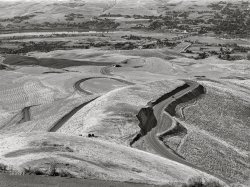
- The Prize: 1921
- ... (so kids with rocks and the coppers can't see you at night).
- ditch the tire pump (weight again).
- blacken the whitewalls ... Posted by Dave - 08/13/2013 - 3:40pm -
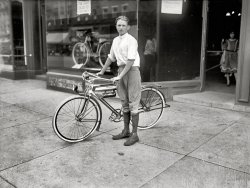
- Hank Aaron: 1934-2021
- ... We were lucky enough to see him hit #712 that Saturday night. We went back on Sunday hoping that with some luck he’d hit two and we ... Posted by Dave - 01/22/2021 - 1:43pm -
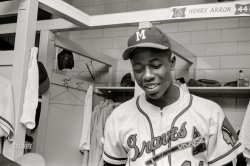
- Friends to the End: 1865
- ... that two male travellers would share a bed for the night. Soldiers often "spooned" for warmth while tenting under open canvas. It ... Posted by Dave - 03/05/2013 - 9:08pm -
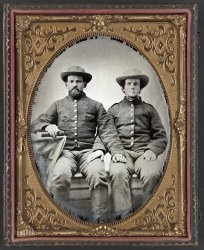
- The Avengers: 1943
- ... day as a secretary and Grandpa worked in the factory at night. This gave my mom plenty of time to sneak off with my father, riding on ... Posted by Dave - 01/09/2013 - 10:03pm -
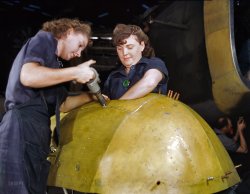
- Road Closed: 1958
- ... They had a wick that burned so they could be seen at night.
Those smudge pots will soon disappear from road construction ... Posted by Dave - 08/12/2015 - 10:41am -
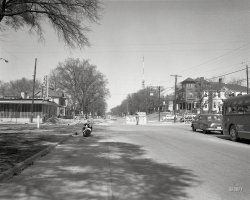
- W.M. Freeny: 1920
- ... love to have seen what the Freeny sign looked like at night, all lit up.
Shorpy viewers are the best! As soon as I saw this ... Posted by Dave - 08/08/2012 - 12:51pm -
![W.M. Freeny: 1920 Washington, D.C., circa 1920. "W.M. Freeny Co., front." The W.M. Freeny men's clothing store on 14th Street. National Photo Co. glass negative. View full size.
Flotsam and jetsamStrange that the photographer would have left that ugly ladder standing there to detract from his photo. And what in the world is it that was won by the Police in 1917? We'll probably never know......
I remember haberdasherieswhose well-trained clerks who worked in such fine stores supplying all manner of men's furnishings. Harry Truman was one before he became president. And they provided such good service that they would do free alterations to make your clothes fit perfectly, even if they were not custom-made.
And then, if you found clothes that would fit, you could go next-door to Velati's and stock up on famous caramels, bonbons, chocolates and pastries.
This was what a typical Main Street looked like when I was young and I must say, I found it much more personal than going into a cavernous super huge warehouse that sells everything under the sun, you push a massive, two-story shopping cart, walk a mile or more to find ALL your needs and finally take a number to check out. Believe me young ones, some things were better in the olden days.
Mysterious LadderThat looks like an extension ladder for work in trees, or maybe street lamps. Fruit pickers had ladders like these, narrow at the top to make them easier to use in the branches, but it would work as well on sidewalk light standards. Probably not the photographer's. The shop window it's propped against (glass already cracked) looks like maybe the display window for a pawn broker. There's also a set of golf clubs and a croquet set in the window with the police trophy, and maybe a radio tuner. The odd array of giblets for sale isn't packed densely enough for a hardware or sporting goods store.
[It's the A.G. Spalding & Bros. sporting goods store at 613 14th Street -- A.G. being Albert Goodwill Spalding of baseball fame. - Dave]
Velati CaramelsMy dad always said that if he had his life to live over, he'd live over a delicatessen. I might choose the Velati Famous Caramels shop.
Freeny lit upLooks like a warm late afternoon when this pic was snapped. I would love to have seen what the Freeny sign looked like at night, all lit up.
Shorpy viewers are the best!As soon as I saw this shot, I wondered just how quickly we'd know about the businesses on either side. You guys are just great. Thank you and Happy Fourth to all!
[More on Velati Caramels here and here. - Dave]
Sporting SpaldingAmazing detective work! So was this store part of a chain?
Where's the window cleaner?The ladder is very likely a widow cleaner's. There are at least a couple of window cleaners here who ply there business walking from location to location, carrying their equipment including a ladder like this.
Albert G Spalding"So was this store part of a chain?"
Yes. Spalding Sporting Goods began when Albert Spalding opened his first sporting goods store in Chicago in 1875 or '76 with his brother. Spalding was a well known pitcher and by 1876 was playing with the Chicago White Stockings (now the Cubs) so his name on a store was going to drive traffic. Spalding published the first guide to the rules of baseball, and an annual Baseball Guide. By 1901 the store in Chicago had grown to a chain of 14 stores. Spalding died in 1915 but the company still exists, although not as a retail entity - it is Spalding Sporting Goods and produces balls for many sports - although as far as I can tell from their website, they no longer make baseballs.
(The Gallery, D.C., Natl Photo, Stores & Markets)](https://www.shorpy.com/files/images/29399u1.thumbnail.jpg)
- Hotel Rochester: 1908
- ... - 1999 "300 all outside rooms" that rented for $1.50 a night. Later it was turned into a dorm for RIT, but it was torn down in 1999. ... Posted by Dave - 08/14/2012 - 11:42am -
![Hotel Rochester: 1908 Rochester, New York, circa 1908. "Hotel Rochester, Main Street and Plymouth Avenue." 8x10 inch glass negative, Detroit Publishing Company. View full size.
Mostly GoneWhile the hotel is gone, the building mostly hidden behind it with the steep roof still stands.
View Larger Map
1907 - 1999"300 all outside rooms" that rented for $1.50 a night. Later it was turned into a dorm for RIT, but it was torn down in 1999.
Mostly goneAnd even the old building that still stands is in disrepair.
Curved RoofDoes anyone have any idea what the building at the next corner, to the left, was? That roof area looks like glass panels, an enclosed garden room, perhaps. It is gone, I think, the "slanty" roof building is still there, as noted, but I don't think they were connected. Interesting.
Curved Roof Bldg.The building with the odd curved roof is the Rochester Savings Bank, built in 1844 and described by one writer as a "fancy wedding cake." It was at the SW corner of West Main & Fitzhugh Streets. Just beyond it (almost at the left edge of the photo) on the SE corner of the same intersection is the Monroe County Building, completed around 1894 and still standing. The building with the mansard roof, just barely visible to the left to the Hotel Rochester, is the Rochester Free Academy. It still stands, but has long ceased to serve as an educational institution.
The once grand Hotel Rochester building was imploded on the Saturday before Christmas, 1999; hundreds of onlookers witnessed the event.
ThanksThe beauty of Shorpy! Thanks, Chip. Still curious about that upper floor where the glass is [or appears to be].
National TheatreDoes anyone know anything about the National Theatre next door? I can't find any references to it.
(The Gallery, DPC, Rochester)](https://www.shorpy.com/files/images/4a18810a.thumbnail.jpg)
- NCR Girls: 1902
- ... if they truly let their hair down when they went home at night?
Nice Work Mostly comfy looking height-adjustable chairs, ... Posted by Dave - 07/26/2012 - 4:59pm -
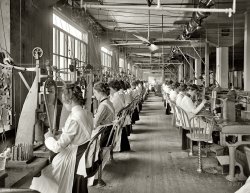
- Modern Nativity: 1953
- ... December 1953. Continuing the Look magazine series "night photographs of houses decorated for Christmas." You know what they say ... Posted by Dave - 12/23/2013 - 7:42pm -
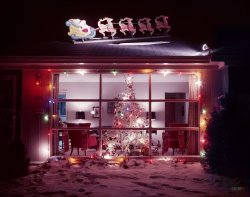
- Where the Sidewalk Ends: 1941
- January 17, 1941. "On a foggy night in New Bedford, Massachusetts." Medium format acetate negative by Jack ... Posted by Dave - 09/28/2019 - 2:46pm -
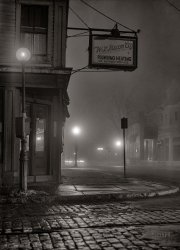
- The Grill Room: 1912
- ... Edelweiss cafe, will ignore the police order of Saturday night.
HVAC I wonder if those 4 wall mounted oscillating fans really ... Posted by Dave - 08/08/2012 - 7:12pm -
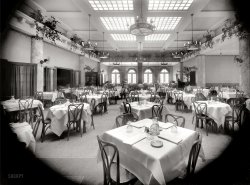
- Now Playing: 1920
- "York Theater, night." Washington, D.C., circa 1920. Among the cinematic offerings: Jack ... Posted by Dave - 07/17/2012 - 10:16pm -
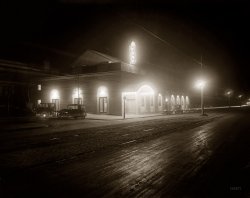
- A Shot in the Dark: 1909
- ... professional, died at the Elgin Asylum for the Insane last night. Demarest suffered a nervous breakdown last June and attacked his wife ... Posted by Dave - 08/19/2012 - 2:57pm -
![A Shot in the Dark: 1909 January 1909. Billiard champion Calvin Demarest in New York, seven years before his prematurely reported death. From his 1916 obituary, headlined "Calvin Demarest Dead -- Noted Billard Player Expires in Illinois Insane Asylum": CHICAGO, Feb. 22. Calvin S. Demarest, former amateur champion billiard player and later a professional, died at the Elgin Asylum for the Insane last night. Demarest suffered a nervous breakdown last June and attacked his wife with a knife. She was saved from serious injury by Demarest's mother. The billiardist was taken for treatment to a rest cure, but failed to improve and was removed to the asylum. As it turned out, Calvin was very much alive. In 1925, though, he died before his time. View full size. George Grantham Bain Collection.
Calvin Lives!Another news item from the day of Cal's 1916 obituary:
DEMAREST, EX-CUE CHAMP, NOT DEAD
ELGIN, Illinois, Feb. 23, 1916. -- Dr. M.C. Hawley, assistant superintendent of the Elgin State Hospital, stated today that he was unable to explain reports that Calvin Demarest, onetime holder of the world's amateur billiard championship, had died. "Demarest is in practically the same condition as when he was committed here several months ago," said Dr. Hawley. "He is in bad mental condition and his case is of the type which deteriorates gradually, but we do not look for death for a long time, unless ho should have a sick spell or an accident."
[Calvin actually died in June 1925 although the news item on his funeral doesn't say what the circumstances were. - Dave]
EyefreakHe probably fooled them into thinking he was dead the first time by using his patented eyefreak trick, as demonstrated above.
Pool TableI have to confess to suddenly knowing less about pool than I thought . . . what kind of pool table is that? Is it wider, are there pockets we cannot see?
[No pockets in carom billiards. - Dave]
Calvin D.He got da crazy eyes!
Lovely picture- the light streaming in, the man in the top hat, the graphic angular shape of the lamps make it for me.
BilliardsWealthy Kentuckian James Findley, to "Fast Eddie" Felson in The Hustler:
"I don't play pool, Mr. Felson. I play billiards."
(The Gallery, G.G. Bain, NYC, Sports)](https://www.shorpy.com/files/images/01660u1.thumbnail.jpg)
- Erie 2601
- ... engines in the world, was derailed at Gulf Summit Sunday night. It was pulling a train of about eighty cars and was running along at a ... Posted by Lost World - 09/22/2011 - 11:39pm -
![Erie 2601 Erie 0-8-8-0 Camelback locomotive at Port Jervis, N.Y., in 1911. The camelback design was unique in that the engineer sat in the tiny cab alongside the boiler, while the fireman worked at the usual spot behind the boiler. One of the main disadvantages was the obvious communication problem between engineer and the rest of the train crew while the engine was in operation. The Erie camelback mallets didn't last long, but smaller camelback locomotives survived well into the 1950's on roads like the Jersey Central. View full size.
Photo's History?What might you know of the photo's history? Interesting shot of a very rare locomotive.
Don Hall
Yreka, CA
Erie 0-8-8-0 CamelbackAt Port Jervis, N.Y., in 1911.I model trains in HO scale. I have never seen anything like this engine. I have seen 0-4-0, 0-6-0 and 0-8-0 camel engines, but never an articulated camel. I have a 2-6-6-2 articulated and have seen the 4-8-8-4 UP engines, but not this one. Anyone know where I could get more pictures of this engine?
Don Rowland - donhotrains@cinci.rr.com
[You could try contacting the person who posted this picture. First sign up for a user account, log in, click on his username, and then "contact." - Dave]
Erie 0-8-8-0 malletThe "Mother Hubbards," sometimes called "camelbacks", common on railroads in the Anthricite (hard coal) region of Pennsylvania. IIRC there weren't many articulated locomotives built this way. I believe this particular type of locomotive was typically used in "helper service," pushing coal trains over the mountains.
The design comes from the need for a very large firebox on locomotives burning hard coal. Hard coal required a fairly thin fire to burn well, thus a large area was required to burn the amount of fuel required to generate enough steam. The fact that they burned the lowest quality of coal available didn't help!
This particular locomotive is interesting in that it is a true compound; notice the size of the front low pressure cylinders compared to the high pressure cylinders on the rear engine. This makes it a "true" Mallet.
It turned out that compounding didn't work as well as expected on railroad locomotives, and later articulated locomotives were built as "simple" engines.
I've never seen any of the larger Mother Hubbards in service, but I did see several of the smaller 0-6-0s and 0-4-0s in active service.
BTW & FWIW - in the 70's we lived in McCloud for four years. Beautiful country in that end of the state!
Erie 0-8-8-0- More photos (Link)There are a few more photos of these engines at:
http://www.rr-fallenflags.org/el/loco/erie-lmn.html
Erie Engine No. 2601 Derailed at Gulf SummitIn my wife's hometown paper (The Deposit Courier), the "Looking Back" section "100 Years Ago, 12 October 1910" says, "Erie engine No. 2,601, one of the largest engines in the world, was derailed at Gulf Summit Sunday night. It was pulling a train of about eighty cars and was running along at a fairly good rate of speed when suddenly it left the track. The big engine pounded along the rails for about 500 yards, cutting off the ends of the ties and tearing up the roadbed for a considerable distance. The Susquehanna wrecking crew was called and repaired the damage."
Only oneThere was only one of this type of locomotive ever built, and it was used for only one thing. Hump work. Basically this engine spent its whole life pushing long trains up the hump of a yard where they would be gravity sorted. The idea behind the placement of the cab was more for visibility than anything. As for communication, the engineer and fireman used their own whistles to communicate between themselves. The engineer used the train whistle, the fireman had a lighter, lower whistle he used.
There were three of theseThere were three of these used for pusher service, not hump service. Only the ERIE had articulated camelbacks, no other road had them. They were all rebuilt later with their cabs at the back.
There were alot of camelbacks in the east and even some western roads had them: Santa Fe, Canadian Pacific, MKT, Chicago & Indiana Coalm, C&IE, to name a few.
There are more pictures all over the Internet, even a color painting.
An HO scale model just sold on Ebay for over $3000.00!
(ShorpyBlog, Member Gallery, Railroads)](https://www.shorpy.com/files/images/erie.thumbnail.jpg)
- Top Brass: 1860s
- ... to. Once in camp they musicians might play for the camp at night and even compete with enemy musicians across the lines for playing best ... Posted by Dave - 05/20/2013 - 1:22pm -
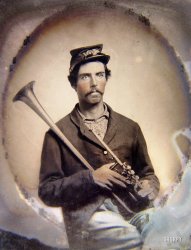
- Family Shelter: 1961
- ... many years later, if I heard heavy aircraft overhead at night, I just *knew* they were Bear bombers. Then I went to work a block from ... Posted by Dave - 07/27/2015 - 5:42am -
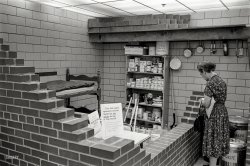
- Rush Hour: 1941
- ... to see that all her paint had peeled off her face with the night dew.These photographs bring back so many memories!
Ditto lisavc. ... Posted by Dave - 06/09/2018 - 3:33pm -
![Rush Hour: 1941 Gas pump with clothesline, barn and horse-drawn wagon in background. View full size. Photographer and location unknown. FSA, 1941 or 1942.
not a great photoordinarily, but fascinating to me, an australian, showing all these ordinary aspects of american life.
The simplicity......of this photo is what draws me in. I mean, there is the contrast of the orange Gulf gas pump against the greens and blues. But, can't you just feel that gentle breeze that's brushin' against the wash on the line moving through your hair and whispering past your ears. A few birds sounding off sporadically in the surrounding brush line. Maybe the limb above the pump scratches lightly against the crown of the Gulf logo. Sigh. Guys, these pictures are...damn...
This picture is not that oldThis photo took me so, that I put it up as wall paper on my desk top. It is a beautiful photgraph, but it is not that old. Look at the power pole in the back ground on the left. The bottom wire is a telephone line, not used in the 40s [well, actually ... see comment above]. The telephone wires used then were open wires on a cross arm with glass insulators. This appears to be a farmstead. The roads are not built up and are with out ditches. I believe that the real road is behind the brush by the power poles. All in all, I like the picture and it looks nice on my computer.
Telephone wiresSingle-strand wires were indeed common in rural areas, but multiplex cabling began to replace them in the 1930s. Similar "three cable" line from LOC archives, photo taken Aug. 20, 1946 by Theodor Horydczak. The gas pump picture is from a roll taken in 1941 or 1942 for the Office of War Information / Farm Security Administration. Here's another photo from the same roll.
I had a doll just like thather name was betty lou and I left her outside in a field and the next morning I was devastated to see that all her paint had peeled off her face with the night dew.These photographs bring back so many memories!
Ditto lisavc. Another AussieDitto lisavc. Another Aussie who loves Americana.
Abandoned gas pump?I suppose that gas pump was no longer in use? There is no indication of a business enterprise around it.
[It would have been used mostly for agricultural equipment. I've seen similar pumps on farms out west.- Dave]
(The Gallery, Gas Stations, Landscapes, Rural America)](https://www.shorpy.com/files/images/1a34447u_0.thumbnail.jpg)
- Corps de Ballet: 1912
- ... N.C. They said they were working and went in to work. At night I counted over thirty children coming out when the whistle blew, and they ... Posted by Dave - 07/22/2012 - 12:44pm -
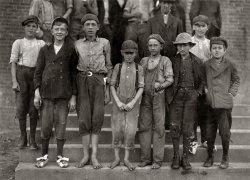
- Hot Rivalries: 1942
- ... helps to support the town's volunteer fire companies. Each night is alloted to a specific group, and there are several hot rivalries. ... Posted by Dave - 01/07/2008 - 7:31pm -
![Hot Rivalries: 1942 January 1942. Bantam, Connecticut. "In the basement of the town firehouse is the bowling alley, revenue from which helps to support the town's volunteer fire companies. Each night is alloted to a specific group, and there are several hot rivalries. Among the women shown here is Mrs. Winfield Peterson, whose husband is foreman of the Warren McArthur experimental shop." View full size. 5x7 nitrate negative by Howard R. Hollem for the Office of Emergency Management.
Ball sizeThe bowling balls pictured seem smaller than today's?
[Those are duckpin balls. No holes. - Dave]
Duckpins or candlepinsFrom the size of the balls I'd guess they're engaging in duckpin or candlepin bowling. These types of bowling use relatively small balls without finger holes.
Also five-pinThat's also the size of the ball in five-pin bowling, but that game is exclusively Canadian.
Bowling DressI thought it was interesting that every one of these women was bowling in a skirt or dress. How things have changed! Already by my childhood 25 years later, all these women would have been wearing pants.
Interesting sheenon Mrs. Peterson's leading leg, perhaps indicating nylon rationing had not yet made its way to her neighborhood. Or, maybe, she had been saving a pair for special times: like this one!
[Or they might be cotton stockings, a nylon substitute that was the subject of about a dozen OWI photos. - Dave]
Re: ConnecticutConnecticut is a lingering stronghold of duckpin bowling. This appears to be that game.
Virginia is for lovers...........of duckpin bowling as well. I grew up in the Hampton Roads area of southeastern Virginia, from the late 50s until I left in 1977 with my new husband of just one year (of marriage, not age, before anyone else comments), right after he got out of the Air Force, having been stationed at Langley AFB for his entire enlistment.
Duckpin bowling was a major force in bowling competition when I was a little girl, and my dad taught me how to bowl in duckpins because the smaller duckpin balls were/are easier to handle by smaller children's hands. I got pretty good at it too. Adult leagues were going strong then, and it was amazing to me to watch the men in the men's and mixed leagues fire those little balls down the alleys like rifle shot at the short, squatty pins waiting at the other end!
It was still quite popular when I left the area for the "Great Midwaste" in 1977, to accompany my husband to his home territory. I haven't heard anything to the contrary since then about it still being quite popular.
(The Gallery, Howard Hollem, Small Towns, Sports)](https://www.shorpy.com/files/images/8e10831u.thumbnail.jpg)
- Disney Vertigo: 1967
- ... walking around inside Mr. Toad's Wild Ride.
Ahhh, Grad Night.
Hurl I went on that ride around 1958 or so with my Mom and ... Posted by Mvsman - 11/17/2012 - 4:26pm -
- Jungle Flivver: 1922
- ...
Palms and ferns "Some Like It Hot" was on TCM last night and potted palms and ferns were used liberally in the sets. Looks like ... Posted by Dave - 09/03/2012 - 6:52pm -
![Jungle Flivver: 1922 April 1922. "Oldsmobile window." The Model 47 "Smaller-Eight Super Sport," $2095 at Oldsmobile Sales Co., 1016-1018 Connecticut Avenue in Washington. National Photo Company Collection glass negative. View full size.
Oldsmobile V-8This car was an exciting and revolutionary for the average American to covet. It was powered with a lightweight V-8 engine. It would be another decade until Ford introduced the Model B V-8 "Deuce Coupe."
http://www.oldsmobile.com/olds/enthusiasts/defaulte659.html
Palms and ferns"Some Like It Hot" was on TCM last night and potted palms and ferns were used liberally in the sets. Looks like the set designer had the right idea.
TiresIs it the lighting, or are both sides of those tires whitewall?
[That's the natural light color of gum rubber. - Dave]
WowThis is not my father's Oldsmobile. What a beauty!
Model B FordThe Model B Ford was a four cylinder car. The 1932 Ford V-8s were Model 18s. Both engines were available across the line, not just in the coupes
Pretty good deal$2095 in 1922 is equivalent to about $27K today, of course GM retired the brand in 2004.
WowThere're so many plants in that window you can hardly spot the car. What's this? A car for every man's jungle?
(The Gallery, Cars, Trucks, Buses, D.C., Natl Photo)](https://www.shorpy.com/files/images/30254u.thumbnail.jpg)
- De Leon Springs: 1904
- ... in the photograph. I would bet things get pretty eerie at night around here. Even now I can hear the bullfrogs, crickets and nocturnal ... Posted by Dave - 09/15/2012 - 12:17pm -
![De Leon Springs: 1904 Volusia County, Florida, circa 1904. "De Leon Springs near DeLand." 8x10 inch dry plate glass negative, Detroit Publishing Company. View full size.
Voodoo settingThis is the perfect setting for a movie about a Voodoo queen, even though it is Florida. Also, in the left side window upstairs there seems to be somebody standing back away from the glass (visible in the lower left pane) as if they do not want to be seen in the photograph. I would bet things get pretty eerie at night around here. Even now I can hear the bullfrogs, crickets and nocturnal sounds of the swamp and smell the steamy, earthy odor wafting over the stagnant water.
[This is a spring, so the water is anything but stagnant. - Dave]
My mistake. I must be smelling something else, maybe the decomposing organic matter.
left bank chateauYou don't string a seine in a swamp. Looks like they caught something.
An artifical poolLocated in Central Florida, DeLeon Springs has a unique history. The spring was utilized as early as the late 1800's to refine sugar and crops by way of a sugar mill. The mill was powered by the spring's strong outflow of water. A retaining wall was built to increase the flow.
DeLeon springs has a basin about 100 yards wide and depths near the center vent are around 25 feet. From the vent, about 4 feet wide, a cave continues for approximately 170 feet.
A retaining wall makes spring look like an artifical pool, and visibilty is not that great in the basin, primarily due to large crowds. Green algae covers the bottom.
Eau de AmbienceAdd some moonlight, some fireflies and some desultory plunking on a fretless banjo, render it all in Color by Technicolor, and this could be the spot-on inspiration for the Blue Bayou Restaurant in Disneyland, a favorite and relaxing spot for late lunches after a morning of too much sun and fun.
Diving platform?Looks like a diving platform up in the tree to the right of the house.
Bewitchin' PoolI sure would like to go there and have some lemonade with Aunt T.
(The Gallery, DPC, Florida)](https://www.shorpy.com/files/images/SHORPY_4a11892a.thumbnail.jpg)
- Adrian C. Anson: 1887
- ... note, this illustration makes the guy look like he's in "Night of the Batting Dead."
"How do I get to the Susquehanna Hat Company?" ... Posted by Ken - 12/04/2007 - 12:20am -
![Adrian C. Anson: 1887 A baseball card for Adrian C. Anson, first baseman for the Chicago White Stockings. Issued by Allen & Ginter Company, 1887. View full size
Another look at "Cap" Anson."Cap" Anson was the was the 1st member of the 3000 hit club.
Origin of cardsI don't know how commonly known this is, but this photo illustrates the fact that baseball cards were originally introduced in cigarette packs in order to keep the cigarettes from bending over. When they later started getting popular with kids they were packaged with bubble gum.
On a totally different note, this illustration makes the guy look like he's in "Night of the Batting Dead."
"How do I get to the Susquehanna Hat Company?"
Blowing Up A Baseball Card To The Size Of A PosterBy my estimation, the "Full Image" version of this is approximately 30 times the size of what it's supposed to be, which would partially account for the somewhat pixilated effect.
[And maybe even pixelated. - Dave]
BatIt's interesting to view the evolution of baseball equipment over the decades, particularly (as this card shows) bats. Today's lumber has much more "meat" at the hittin' end, with a tapered handle that probably allows for higher swing speeds. Could this be due to better wood selection, lathing and curing techniques by the folks down there in Louisville? The lumber swung by the hitters of today's game make Cap's bat look like a fat stick.
Ginter = Richmond industrialistLewis Ginter:
http://en.wikipedia.org/wiki/Hollywood_Cemetery
http://www.lewisginterrecreationassoc.org/history.html
Major Lewis Ginter (1824 - October 1, 1897) was a prominent businessman, army officer, and philanthropist in Richmond, Virginia
Of Dutch ancestry, he was born Lewis Guenther in New York City, New York, he moved to Richmond, Virginia in 1842. Ginter had a number of careers, arguably making and losing a fortune three times. Ginter amassed a great fortune in the tobacco industry via new technology for rolling cigarettes. He used this massive fortune to act as a philanthropist and for the development of civic and business interests in Richmond. He developed the neighborhood Ginter Park and brought the Union Theological Seminary there. His niece Grace Arents continued his philanthropy, spurring the development of St. Andrew's School, the Instructional Visiting Nurse Association and the Lewis Ginter Botanical Garden at her home Bloemendaal.
He served with the Confederate States Army during the American Civil War, rising to rank of Major. His residence Ginter House sits on the Monroe Park campus of Virginia Commonwealth University.
Hired on to the John Allen & Co, he became a partner of the Allen and Ginter tobacco company that ushered in a number of innovations including cigarette cards and the use of local Virginia tobacco. In 1890 Ginter's company joined forces with James B. Duke to form the American Tobacco Co..
Ginter also commissioned the design and construction of the luxurious Jefferson Hotel Richmond, which opened in 1895.
Anson helped erect the pro baseball color barrierhttp://www.capanson.com/chapter4.html
Cap Anson was (common for the era, even in his native Iowa) a bigot. His racial attitudes were stronger than most, however, and he led efforts to exclude blacks from professional baseball.
Note that Jackie Robinson was NOT the first black to play in the major leagues -- both Fleet and Welday Walker played in 1884 before the color barrier limited baseball to the (ahem) melanin-impaired.
(Sports)](https://www.shorpy.com/files/images/0002fu.thumbnail.jpg)
- Heeeere's Johnny: 1965
- ... from that era.
Johnny was the best King of Late Night. There never will be anyone like him again. It's nothing but an ... had game and energy. The later shows kept, re-run every night, show a still-witty sophisticate and his longtime staffers generally ... Posted by Dave - 02/11/2019 - 10:11pm -
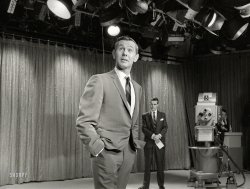
- Bathtime for Joey: 1943
- ... off of a baby spoon.
My sons also slept through the night around six weeks of age. Now I have three strong teenage sons and not ... Posted by Dave - 09/09/2011 - 11:01am -
![Bathtime for Joey: 1943 December 1943. "Lynn Massman, wife of a second class petty officer studying in Washington, D.C., giving eight weeks old Joey his daily bath." The Massman family was the subject of dozens of photos shot by Esther Bubley for the Office of War Information. View full size. Epilogue: Joe, a lawyer, died in March 2000 in Montana. His dad, Hugh, died two years later. Lynn, a mother of eight, passed away in 1983 after a very active life. Click here for remarks by her son Bascomb.
Any info on Lynn?When did she die?
[In 1983 (see above). More on the Massmans in this thread. - Dave]
Lynn MassmanLynn died before her sister Elaine passed away in 2001. Elaine's obituary.
[Thanks, Joe. - Dave]
Lynn's passingI'm Lynn's sixth child. Her fourth son. She died in 1983 of cancer. She would have made a great old lady.
[Thanks for filling in the gaps. - Dave]
More on LynnThe confusion could have been caused by her name change. When Lynn died she had not only remarried to Julius "Babe" Stoner, but she had taken to spelling her name Lyn. She made that move in the seventies when she ran for the state Senate in Montana--and nearly won. If it had been after Watergate instead of before, she probably would have won.
Re: JoeyThe size of Joey at eight weeks doesn't surprise me. All three of my sons were also chunky at eight weeks. Their pediatrician instructed me to start my sons on baby cereal at two weeks with pureed fruits and vegetables.
By around six weeks, I was instructed to add pureed beef roast or chicken into their cereal for dinner.
Of course this was served in tiny amounts off of a baby spoon.
My sons also slept through the night around six weeks of age. Now I have three strong teenage sons and not one of them has an allergy. Go figure!
JoeyJust have to ask - are you sure that's an 8 WEEK old baby and not 8 MONTHS??? I'm sorry to question, but my baby is just about to turn 18 months next week and she was not anywhere near the size of Joey in this picture until 8 or 9 months, and she was 8 lb 2.5 oz at birth and has remained in the higher percentiles of weight & height to date!
[Eight weeks seems to be correct. Joey was born in October 1943. - Dave]
Joey MassmanThe Massmans are all big folks. Joe was 6 foot 2 and about 275 pounds before the cancer thinned him down in his last weeks. I'm 6'5 and 210. My daughters were both over 10 pounds at birth. I always say "Massman" is just another way of saying "big guy."
(The Gallery, D.C., Esther Bubley, Kids, Massman, WW2)](https://www.shorpy.com/files/images/8d41938u_0.thumbnail.jpg)
- Government Connections: 1959
- ... work long, telling us they could make $80 in a single night, dancing in the bars. Our Chief Operator didnt like men in her crew. ... Posted by Dave - 11/29/2013 - 8:26pm -
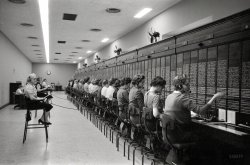
- Drawing Room 1920s
- ... sconces on the walls. We would light them just for fun as night illumination. No lamps - just the gas coming straight out of the ... Posted by Joe - 09/22/2011 - 11:09pm -
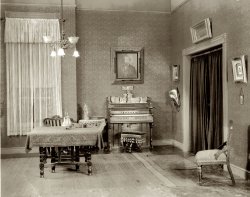
- Pilot Project: 1938
- ... Morrison, Arcadia (Calif.) High School student, last night was awarded a trip to Miami as winner of the National Air Mail Week essay ... Posted by Dave - 12/15/2013 - 11:14pm -
